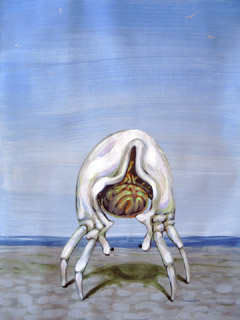
"Pak Mozg" roughly translates from Russian to English as "brain crab." It is a species that has recently been found on the southwestern coast of Novaya Zemlya -- an archipelago to the north of Russia, relatively close to Scandinavia.
What makes this crab interesting is that it has an exceptionally large brain, which dangles exposed beneath its dorsal shell. The ventral shell is entirely missing. This makes the crab quite vulnerable to attacks from seagulls -- but it is also, presumably, what makes the prodigious brain development physically possible.
The typical adult Pak Mozg is approximately 10" wide and 14" tall. Its dorsal shell is high and crested, which makes it look somewhat like a helmet. To an extent, this unusual shape helps deflect gulls' attacks.
If the crab is turned over, you can see the web of its nervous system adhered to the shell -- as well as a vestigial stomach lining. The creature seems to subsist solely upon zooplankton, which are captured by a swath of microscopic flagella. Two beady black eyes dangle from protuberances at the front of the shell. The only significant musculature occurs within the creature's four legs.
From 1954 to 1990, Novaya Zemlya was used as a nuclear test site; in the end, it hosted a grand total of 224 detonations. While there is no definite link between the tests and the appearance of the Pak Mozg, the concurrence of these events merits further investigation.
At this point in time, it seems that only a handful of fishermen have taken note of the new species. The ones I've spoken to jokingly refer to it as "the intellectual." When they see gulls flip the crabs over and peck out the brains inside, wry comments are made about the appetites of these "government agents."
Whether or not Pak Mosgs survive into the future is uncertain. On the one hand, they are astonishingly vulnerable to predators -- which seem to enjoy the crabs as a sort of delicacy. On the other hand, the animal displays a high degree of intelligence and adaptability.
It is known, for instance, that the first recorded generation of crabs attempted to lay its eggs on land in the daytime -- and was consequently slaughtered en masse by hungry birds. In the following generation -- several years later -- the crabs appear to have avoided the threat by laying their eggs at night. The most recent generation is reported to have stolen nets from nearby fishing boats -- and actually laid rudimentary traps for the predators.
It will be very interesting indeed to see how this trend develops over time.


No comments:
Post a Comment